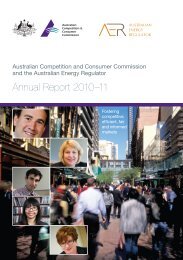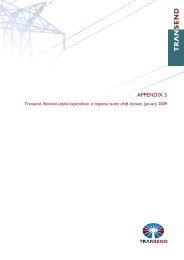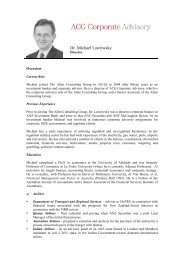Internal consistency of risk free rate and MRP in the CAPM
Internal consistency of risk free rate and MRP in the CAPM
Internal consistency of risk free rate and MRP in the CAPM
Create successful ePaper yourself
Turn your PDF publications into a flip-book with our unique Google optimized e-Paper software.
For this review, we consider that <strong>the</strong> value <strong>of</strong> <strong>the</strong> <strong>risk</strong> <strong>free</strong> <strong>rate</strong> is currently well<br />
below long term averages <strong>and</strong> that <strong>the</strong>re is a high level <strong>of</strong> market uncerta<strong>in</strong>ty.<br />
We consider <strong>the</strong> <strong>risk</strong>s <strong>in</strong> sett<strong>in</strong>g a 5-year determ<strong>in</strong>ation <strong>in</strong> <strong>the</strong> current conditions<br />
are more significant than under normal market conditions.<br />
We acknowledge <strong>the</strong> argument that <strong>the</strong>re may be greater stability <strong>in</strong> <strong>the</strong> sum <strong>of</strong><br />
<strong>the</strong> market <strong>risk</strong> premium <strong>and</strong> <strong>the</strong> <strong>risk</strong> <strong>free</strong> <strong>rate</strong> (i.e., <strong>the</strong> expected market return)<br />
than <strong>in</strong> <strong>the</strong> <strong>in</strong>dividual components. In <strong>the</strong> current market circumstances, <strong>the</strong>re is<br />
some evidence, as SDP noted, to support <strong>the</strong> view that expectations for <strong>the</strong><br />
market <strong>risk</strong> premium have risen as bond yields have fallen.<br />
144. Consistent with this analysis, IPART set a WACC towards <strong>the</strong> top <strong>of</strong> its range. Its<br />
stated reason for do<strong>in</strong>g so was as set out below 47 :<br />
We determ<strong>in</strong>ed <strong>the</strong> values for <strong>the</strong> parameters <strong>of</strong> <strong>the</strong> WACC based on market<br />
conditions over <strong>the</strong> 20 days to 28 October 2011. The <strong>risk</strong> <strong>free</strong> <strong>rate</strong> <strong>and</strong> debt<br />
marg<strong>in</strong> have been affected by market volatility <strong>and</strong> <strong>the</strong> prolonged weak market<br />
follow<strong>in</strong>g <strong>the</strong> credit crisis <strong>of</strong> 2008. The change <strong>in</strong> <strong>the</strong>se factors has potentially<br />
created a disparity between <strong>the</strong>se parameters (for which we use short term<br />
average data) <strong>and</strong> <strong>the</strong> market <strong>risk</strong> premium (for which we use long term average<br />
data).<br />
However, <strong>the</strong> effects <strong>of</strong> this disparity are mitigated by our decision to use a po<strong>in</strong>t<br />
estimate <strong>of</strong> 6.7%, which is 80 basis po<strong>in</strong>ts higher than <strong>the</strong> midpo<strong>in</strong>t <strong>of</strong> our<br />
estimated WACC range. In do<strong>in</strong>g so, we had strong regard to <strong>the</strong> calculated<br />
WACC us<strong>in</strong>g longer term averages for market parameters.<br />
145. In addition, <strong>the</strong> Essential Services Commission <strong>of</strong> Victoria (ESCV) determ<strong>in</strong>ed that<br />
government bond markets were abnormally affected by <strong>the</strong> maturity <strong>of</strong> a large<br />
proportion <strong>of</strong> <strong>the</strong> relevant CGS market which it believed led to shortage <strong>of</strong> supply <strong>of</strong><br />
<strong>the</strong>se bonds <strong>and</strong> a downward bias <strong>in</strong> yields (not<strong>in</strong>g that yields are <strong>in</strong>versely related to<br />
<strong>the</strong> price <strong>of</strong> a bond). 48 Consequently, <strong>the</strong> ESCV chose to adopt an averag<strong>in</strong>g period<br />
from before this event. The ESCV stated:<br />
[…] <strong>the</strong> Commission’s preferred response is to identify a measurement period<br />
that is not <strong>in</strong>fluenced by <strong>the</strong> downward bias, <strong>and</strong> to sample <strong>in</strong>terest <strong>rate</strong>s from<br />
that period. Data after August cannot be relied upon at this time as it is unclear<br />
for how long <strong>the</strong> downward bias may persist. On this basis, <strong>the</strong> Commission<br />
considers that it is appropriate to use <strong>the</strong> latest market evidence available prior<br />
to <strong>the</strong> bias<strong>in</strong>g event. The Commission has <strong>the</strong>refore applied a measurement<br />
period for <strong>the</strong> calculation <strong>of</strong> <strong>the</strong> <strong>risk</strong>-<strong>free</strong> <strong>rate</strong> as <strong>the</strong> last 20 trad<strong>in</strong>g days <strong>of</strong> July<br />
47 Ibid., section 9.1, page 80.<br />
48 The yield is <strong>the</strong> percentage return on a bond. Given that <strong>the</strong> stream <strong>of</strong> future payments is predeterm<strong>in</strong>ed, <strong>the</strong> higher <strong>the</strong><br />
price paid for <strong>the</strong> bond <strong>the</strong> lower <strong>the</strong> percentage return on <strong>the</strong> bond, i.e. <strong>the</strong> lower <strong>the</strong> yield.<br />
Competition Economists Group<br />
www.CEG-AP.COM<br />
39







